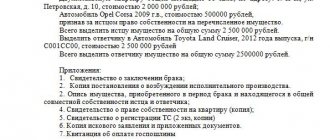11
Article 38 of the RF IC allows for the possibility of dividing property both after divorce and directly during marriage.
Based on established practice, it is permissible to file a claim for division of property together with a claim for divorce in one statement of claim.
This option for exercising one’s rights is possible if the marriage, according to all the rules, must be dissolved through the court, that is, in cases where:
- The spouses have minor children, and the consent or disagreement of both spouses does not matter;
- One of the spouses did not give his consent to the divorce even in the absence of children.
Expert opinion
Stanislav Evseev
Lawyer. Experience 12 years. Specialization: civil, family, inheritance law.
In addition to the division of property, you can also make a claim to determine the child’s place of residence and to collect alimony. However, be prepared for the fact that a claim with such a large number of requirements can take a very long time to be considered, even despite the fixed period of 2 months.
Lawyers do not recommend combining the listed requirements if there are disagreements between spouses about the method of dividing property and raising children. This will lead to a delay in the process, because 1 month is given for the consideration of a divorce case, and at least 2 months for the division of property, without taking into account the time limits for suspending the case in the event of an examination being ordered.
Important! If a marriage can be dissolved through the registry office, there is no need to demand its division through the court.
How to correctly write an application for divorce and division of property
A correctly drafted statement of claim is half the battle. When the court can immediately determine all the features of the case, clearly understand the existing relationship with the spouses and identify for itself the property rights of each of them, it will be more likely to make the right decision (from the point of view of the plaintiff). Therefore, when drawing up a document, it is very important to describe in detail all the features of cohabitation, which became the cause of the dispute over the division of property, and be sure to confirm them with documents.
Example : If the plaintiff wants to divide an apartment received by the defendant by inheritance, he must prove that this property became jointly acquired as a result of major renovations carried out by the family during the marriage. This fact must be confirmed by receipts from construction stores, statements from the spouses’ accounts, video and photographic materials, as well as an agreement with the repair team.
Rules for drawing up an application
The rules for drawing up statements of claim are regulated by the Code of Civil Procedure of the Russian Federation (Code of Civil Procedure). In particular, Article 131. This document must contain the following information:
- Name of the court to which the application is being filed.
- Information about the plaintiff and defendant.
- Information about marriage (moment of conclusion and dissolution).
- Information about children (if any).
- The price of the claim and the amount of the state duty (to determine them, you need to conduct an assessment of the disputed property).
- The essence of the appeal, which indicates the characteristics of life in marriage and the reasons that led to divorce. It is also indicated on what basis this or that object can be joint or personal property and why its division is required, as well as in what form.
- A list of objects, including real estate and transport, that are subject to division.
- The plaintiff's demands (for example, to dissolve the marriage and divide the specified property).
- Document attachments.
- Signature and date.
Features of document preparation
When drawing up a statement of claim, the following features must be taken into account:
- If there is a prenuptial agreement, when preparing a claim, you need to rely on exactly the provisions that are specified in this agreement.
- According to general rules, personal property (became property before marriage, gifted or inherited) is not subject to division. However, under certain conditions, it can be recognized as joint property and then divided.
- Things, school supplies, toys and other items belonging to minor children are not subject to division. They remain with the parent with whom the child remains.
- Not only joint property, but also the debts of the spouses are subject to division.
- Before filing a claim, it is necessary to evaluate all the disputed property. The appraisal must be carried out by a licensed company that has the right to determine the market value of these objects.
Procedure
- Determine the list of property that is planned to be divided. It is understood that it was not possible to carry out the division on a voluntary basis.
- Conduct an assessment of the specified property.
- Select the court to which the application will be filed.
- File a claim.
- Pay the state fee.
- Get a court decision.
- Act in accordance with the points of the decision.
Preparing a claim and filing it
The requirements for the content of the claim are regulated by the provisions of the Code of Civil Procedure of the Russian Federation, in particular Art. 131-132 Code of Civil Procedure of the Russian Federation.
Compliance with the requirements listed in them is mandatory, otherwise a document drawn up in violation of these articles is left without movement to eliminate the deficiencies or is returned to the applicant in a number of cases.
These articles establish requirements for claims of any category, listing the general requirements for the document. In relation to claims for divorce and division of property, the requirements for maintenance are not established by law.
The following information must be included in the claim:
- Name of the judicial authority and its location;
- Full names of the defendants, their addresses and contact information;
- Circumstances for filing a claim: date of marriage; actual termination of marital relations, etc.
- Reasons for divorce.
- Information about the presence of children, if any;
- An indication of the consent or disagreement of the second spouse to divorce, an indication of the impossibility of saving the marriage;
- List of property that needs to be divided and information about it: date of purchase; price; details of title documents;
- A reference to the position of the second spouse on the issue of division of property, his consent or the essence of the objections. If partial agreement is reached, indicate this.
- Proposals for the division of property, motivated by evidence;
- Request to the court for dissolution of marriage and divorce;
- List of attachments, date of compilation and signature.
The statement of claim is submitted in person to the court reception or sent by registered mail to the court. A claim can also be filed by a representative of the plaintiff, who has a duly issued judicial power of attorney.
From January 1, 2021, it is possible to file a claim via the Internet, but for this the plaintiff must have an electronic digital signature. Submission of documents is carried out through the ESIA system, which is part of the State Services service.
In relation to the rules for filing a claim, each situation of division of property is individual. Only an experienced lawyer can correctly determine all the circumstances to be indicated in the application. Before drawing up a statement of claim, it is strongly recommended to enlist the support of an experienced lawyer, having first consulted with him.
Attached documents
Each statement of claim, in addition to a receipt for payment of the state fee, must be accompanied by all documents confirming the text of the appeal to the court. In this case, this may be a marriage certificate, certificates of ownership of the disputed property, receipts, checks, wills and other papers that in one way or another can influence the court's decision.
The defendant also receives the right to provide his own versions of the specified documents, which can confirm that he is right.
Documentation
Without documents that confirm all the circumstances listed in the statement of claim, acceptance of the claim and its consideration by the court is impossible.
When compiling a package of documentation, you should be guided by Article 132 of the Code of Civil Procedure. The exact and complete list of documents depends on the circumstances of a particular case, but below is an approximate list of documents that should be attached to a claim for divorce and division of marital property. If you have any questions during the process of preparing documentary attachments for the claim, ask them to the lawyers of our portal.
So, the following documents must be attached to the claim for divorce and division of marital property:
- Copies of the statement of claim with all attachments (the number of copies must correspond to the number of participants in the trial);
- A document confirming payment of the state fee for filing a claim;
- Copies of passports of spouses (plaintiff and defendant);
- A copy of the marriage certificate;
- Copies of children's birth certificates;
- Copies of title documents for personal and joint property, property of children (sale and purchase agreements, donations, certificates of inheritance, privatization, exchange);
- Copies of appraisal documents for the disputed property;
- Copies of documents on personal or joint debt obligations (loan agreements, promissory notes, bank statements, certificates of debt, court decisions and writs of execution, letters and notifications from the joint venture company, checks and receipts for regular payments);
- Copies of documents confirming the improvement of the personal property of one of the spouses at the expense of joint funds during the period of marital relations (photos, contracts for the performance of work or provision of services, checks, receipts for the purchase of materials, spare parts, expert assessments, witness statements);
- Copies of documents confirming the expenditure of funds from the family budget by one of the spouses contrary to the interests of the family, confirming the advisability of reducing the share;
- Copies of medical documents on the health status of one of the spouses or a child, confirming the advisability of increasing the share.
If the statement of claim contains additional claims (for example, about the assignment of alimony or the choice of the child’s place of residence), the list of documents will be expanded to confirm additional information and substantiate the claims.
Read more about documents in the article “What documents are needed for divorce?”
State duty
Division of jointly acquired property refers to property claims. The amount of the state duty is regulated by subparagraph 5 of paragraph 1 of Art. 333.19 Tax Code of the Russian Federation. At the same time, divorce through the court is a separate action, payment for which is regulated by subparagraph 5 of paragraph 1 of Art. 333.19 Tax Code of the Russian Federation.
In total, the plaintiff will pay 600 rubles for divorce, and for the division of property - from 400 to 60 thousand, depending on the price of the statement of claim.
Example : If an apartment costs 3 million rubles, but the plaintiff claims only half, 1.5 million is taken into account.
At the same time, according to the last paragraph of subclause 1 of clause 1 of Article 333.19 of the Tax Code of the Russian Federation, if the value of the claim is over 1 million, the calculation is made on the basis of 0.5% of the excess amount, to which a fixed payment of 13,200.00 rubles is added. In our case, it will be 0.5% of 500 thousand = 2500.00 + 13200.00 = 15700.00 rubles.
Deadlines
The consideration of a divorce case and the related division of property takes 2 months. In practice, this period can increase significantly, especially in the presence of difficult circumstances or a high workload of the court. On average, before the preliminary hearing, from the moment the claim is filed, it usually takes about 1 month. Then, after another 1-1.5 months - the main meeting. And only based on its results, if it was possible to resolve all controversial issues, after 5 days a decision is issued to the plaintiff and defendant.
From this moment, either party has 1 month to appeal it, after which it comes into force and nothing can be changed.
According to general rules, disputes of this kind have a statute of limitations of 3 years, however, given the fact that spouses divide property simultaneously with the divorce, in our case this period is not relevant, since it begins to count from the moment of divorce.
How to write a statement of claim correctly
On the one hand, a statement of claim is a formal document that is necessary to carry out the procedure for dissolution of marriage and division of property. Therefore, it must comply with the form established by procedural legislation (Article 131 of the Code of Civil Procedure of the Russian Federation) for such documents. Inconsistency of the form of the claim with procedural norms may cause the judicial authority to refuse to accept the claim for consideration and return it to the plaintiff to correct errors.
On the other hand, the content of the statement of claim is no less important, especially if, in addition to claims for divorce, other claims are also filed, in this case, for the division of joint marital property . The more accurate and detailed all the circumstances are presented, the more complete and comprehensive the court’s examination of the case will be, the more reasoned the arguments, the more reliable the evidence presented, the more likely it is that the court will resolve the dispute in favor of the plaintiff.
So, the claim must contain the following information:
- Name of the judicial authority;
- Information about the spouses (plaintiff and defendant): full name, place of residence, contact telephone number;
- Information about third parties, if they are involved in the court case (for example, creditors in a case regarding the division of debt obligations): name, location;
- Cost of claim;
- Amount of state duty;
- Title: “Statement of claim for divorce and division of joint property”;
- Information about the marriage: when and by which registry office the marriage between the parties was registered;
- Information about the presence of minor children: Full name, date of birth, place of residence;
- Information about the spouse’s consent or disagreement to divorce. If the spouse does not agree to divorce, it is necessary to indicate why the preservation and continuation of the marital relationship is impossible. It is not necessary to dedicate the court to the details of family life, unless this information is decisive for the case (for example, information about harsh treatment when determining the future place of residence of children), since the court does not evaluate the reasons prompting one of the spouses to demand a divorce. General phrases are enough, for example: lack of mutual understanding, differences in values and life goals (see “Reasons for divorce in the statement of claim“).
- A complete list of property acquired during the period of married life with a detailed description and indication of the value of each property;
- Information about the personal property of each spouse that is not subject to division. Justification for the need to recognize the right of joint ownership of personal property in accordance with Art. 37 RF IC. Links to supporting documents;
- Information about debt obligations (for loans, including mortgages, for promissory notes): for what purpose the funds were used (personal or family), the original amount of the debt, the date and amount of payments, the amount of unpaid debt subject to division, the amount accrued interest, fines, penalties. Links to supporting documents (see “Is it possible and how to divide a loan during a divorce?”);
- Justification of how joint marital property should be divided: a list of property assets that should go to the plaintiff and defendant;
- Justification of the amount of monetary compensation that must be transferred to the plaintiff or defendant in connection with the indivisibility or unequal division of property;
- Justification for increasing the plaintiff’s share or decreasing the defendant’s share (if there are circumstances provided for in paragraph 2 of article 39 of the RF IC);
- Links to family law norms: Art. Art. 22, 23, 34, 37, 38, 39 SSC RF;
- Heading "Please";
- Claims: for divorce, division of joint property of spouses;
- List of attached documents;
- Date of;
- Signature.
In addition to the claims listed above (for dissolution of marriage, division of property of spouses), the claim may contain others, depending on the circumstances, for example:
- about the place of residence of joint minor children;
- on the collection of child support;
- on the recovery of monetary maintenance from one spouse to the other.
Accordingly, the statement of claim must contain the necessary information, and supporting documents must be attached to the claim.
Rules for filing a claim for divorce and division of property
If the value of the claim exceeds 50 thousand rubles, the issue of divorce and division of property (as well as any other issues related to this procedure) are considered in the district court. If the value of the claim is less than 50 thousand, the decision will be made by the magistrate court at the place of registration/residence of the plaintiff or the location of most of the disputed property.
When considering a case, decisions may be made simultaneously regarding other factors related to it. For example, establishing the amount of alimony or determining the child’s place of residence. It is recommended to provide for all of them when filing a claim.
Settlement agreement
If during the consideration of the case in court, but before the decision was made, the parties were still able to agree and come to an agreement that suits them, they can enter into a “Settlement Agreement”. In fact, this means that instead of a court, the decision is made by the parties to the conflict, and the judicial authorities only approve it. Of course, this is only possible if the parties have a desire to negotiate and the ability to find “common ground.”
Example : Initially, the wife planned to demand that her husband pay her monetary compensation for half of the apartment owned by the former spouses as joint property. However, the husband could not afford to make such a payment. At the same time, he doesn’t really need this property. In such a situation, the spouses agree that the wife takes the apartment for herself, and the husband also becomes the personal property of the jointly acquired car and dacha.
Interim measures for division of property
If there is a threat of loss or damage by the defendant to the property declared for division, the plaintiff may apply for the application of measures to secure the claim to the disputed property.
These measures may be requested by the plaintiff and imposed by the court:
- Seizure of property with a ban on its disposal and transactions.
- Prohibition of use of property.
- Seizure of bank accounts.
A request for interim measures can either be indicated immediately in the claim or stated in a separate document if it is necessary to present additional evidence of the threat of loss of property.
Features of civil marriage
A civil marriage is currently not recognized as equal to an official one, and therefore all property purchased by one of the “spouses” is considered his personal property, regardless of how and under what circumstances it was acquired. The main problem when dividing such property is to prove that a particular object is truly joint property. More often than not, it is almost impossible to prove this. In practice, when trying to divide property between people living in a civil marriage, both parties usually remain with their own. That is, with those objects that are registered personally to them.
The difficulty of dividing property is primarily due to the lack of evidence that it was acquired during marriage. This is not a problem when all the receipts, contracts and agreements are available, but many married couples rule out the possibility of divorce until the last moment and do not keep such documentation. We recommend discussing all the specifics of your case during a free consultation with our lawyers. They will help develop the basic rules and position of the plaintiff, and will also act as representatives in court, thereby significantly increasing the chances of a successful resolution of the case.
FREE CONSULTATIONS are available for you! If you want to solve exactly your problem, then
:
- describe your situation to a lawyer in an online chat;
- write a question in the form below;
- call Moscow and Moscow region
- call St. Petersburg and region
Save or share the link on social networks
- FREE for a lawyer!
Write your question, our lawyer will prepare an answer for FREE and call you back in 5 minutes.
By submitting data you agree to the Consent to PD processing, PD Processing Policy and User Agreement
Useful information on the topic
Claim for division by sale of an apartment
Selling an apartment for the purpose of dividing the proceeds between the owners is...
5
How to seize property during a divorce
The division of property almost always causes numerous problems for...
3
Divorce without division of property
Divorce is not always associated with the division of property. In some…
5
Division of inheritance in case of divorce between spouses
Article 36 of the Family Code of the Russian Federation states that property received...
6
Division of gifted property during divorce
In the process of divorce, almost every married couple faces...
1
Joint will of spouses
The legislation of the Russian Federation prohibits citizens from leaving joint wills, regardless of...






